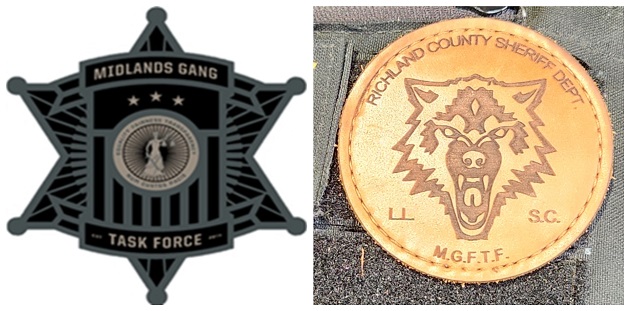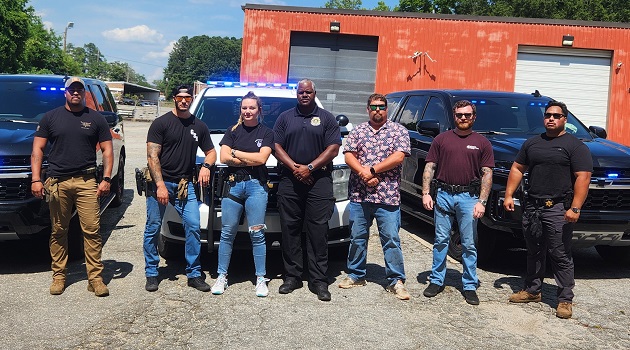The Midlands Gang Task Force is thwarting violent gangs and gang-related criminal activity in central S.C.
By W. Thomas Smith Jr.
Gathered around a table in one of the Richland County Sheriff’s Department’s substations in a somewhat isolated stretch of north Columbia, S.C., Lieutenant Stephen Dauway, Corporal David Castro, and several regional investigators with the Midlands Gang Task Force met, Monday, June 24, to discuss ongoing investigations, new intelligence, forthcoming operations, potential gang-leader targets, who’s traveling with whom and where, and what informants are saying.
The gathering was a weekly meeting where plans were made and new information shared among members of the Midlands Gang Task Force (MGTF), a multi-agency unit led by the Richland County Sheriff’s Department (RCSD) and including – under a memorandum of understanding (MOU) – partnering law enforcement agencies from across central S.C., a few federal agencies, and the Fifth Judicial Circuit Solicitor’s Office (with an assigned Assistant Solicitor)
Not all agency representatives attended the June 24 meeting, but an attorney with the Solicitor’s Office was present as were several RCSD investigators and unit supervisors; RCSD’s Dauway, the MGTF commander who led and facilitated the meeting; and an officer with the Columbia Police Department. Many of the other MGTF agency leaders are expected to attend the larger monthly meeting later in July.

Those present in the June 24 meeting discussed everything from existing gang databases, potential high-value targets, gun “switches” (a tool in which gang members convert semi-automatic handguns into fully automatic press the trigger and spray weapons), and whether or not RCSD’s Special Response (SWAT) team might be employed in an upcoming counter-gang operation.
The Special Response Team is not always employed in serving or executing gang warrants. “The task force itself handles about 95 percent of its own missions in-house so to speak,” said Cpl. Castro, one of the supervisory MGTF investigators prior to the meeting. “The Special Response Team [SRT] is utilized when the targeted gang leader or leaders meets a particular threshold of known violence or potential high-risk to our people.”
According to Castro, that operational 95-percent is part of what makes the MGTF unique. “We are fully capable of running most missions solely through the MGTF,” he says.
Capable indeed and unique in terms of how it operates, MGTF leaders see their overall mission and day-to-day work as fourfold: Narcotics (tactics and surveillance), investigations, patrol officer work (aka street cops), and education.
“First of all we work narcotics just like any other narcotics unit would,” said Castro. “We pay criminal informants. We conduct surveillance on targets. We execute our own search warrants. And rather than outsourcing work, we start the investigations, get the search warrant, then [if need be] end up kicking in doors.”
Castro adds: “Our means of getting to gang members is through narcotics investigations. High-ranking gang members, nine-times-out-of-ten, are going to be involved in narcotics sales. What separates us from an actual narcotics unit is that a narcotics unit works anything that is drug related. Whereas we work it when there is gang member focus.”
There is overlap. “Yes, so we often provide support to the [RCSD] Narcotics Unit in their own investigations.”
Castro says the ultimate goal is arrest the gang member, gather additional information to be processed into finished intelligence on a given gang such as gang-member “validations,” who’s who and whose doing what, and collecting phone downloads.
“That’s really the first component unique to the task force,” he said.
The second component of the four is Investigations. “We are investigators.” said Castro. “We work gang-related murders.”
Thirdly, MGTF members are regular patrol officers. “We are also street cops,” said Castro. “We conduct traffic stops in high-crime areas: Crime suppression. We monitor our shot-spotter program. We gather intelligence and statistics [RE: Where specifically in the Midlands firearms are being discharged].”
Shot spotter provides accurate gunshot readings for law enforcement in terms of times and locations of gunshots.
Fourth and lastly is the educational component for schools, hospitals, and civic organizations requesting such. As educators, MGTF leaders address specific gangs, activities unique to a given gang, gang trends, and what to look for. “In hospitals for instance, gunshot victims will often say things to nurses that is informationally important to us,” said Castro.
For the past several years, the MGTF has been tasked with disrupting and dismantling illegal gangs operating throughout the Midlands of South Carolina. The task force has been largely successful, but gangs are continuing to evolve. Recruiting is becoming more sophisticated. And the dynamic of gang activity is becoming more dangerous nationwide. S.C. is no exception.
Human trafficking is a problem in central South Carolina, but that’s often worked by the MGTF’s federal partners like the FBI and the Department of Homeland Security, says Castro.
Firearms proliferation and drug trafficking are currently the biggest challenges for the MGTF with the increasing popularity of the extremely dangerous drug, fentanyl. “The popularity of fentanyl is that it is relatively very cheap,” said Castro.
Gang recruitment is also becoming an expanding challenge with an increasing number of far younger potential gang-members (primarily young males) being recruited online. “In the past, gang-members were recruited within a given neighborhood or geographic region,” said Castro. “Today, they are being recruited through social media like Instagram and Facebook which greatly expands the gangs’ reach.”
According to Castro, so-called “influencers” on social media post pictures of money, weapons, and narcotics. “This piques the interest of youth,” he said. Group chats are developed with up to 15-20 or so individuals with ‘influencers’ providing gang knowledge, rules of the gang, brands or hashtags used on social media, gang missions like automobile break-ins searching primarily for firearms, narcotics sales, even shootings and planned murders.”
Gangs are different and constantly evolving.
Hybrid gangs for instance are multi-regional gangs, sometimes multi-ethnic, coordinating efforts within a single gang entity.
“With hybrid street gangs you’ll often see white guys predominantly rolling with black guys, and every now and then Hispanic guys rolling with black guys and creating a gang,” says Castro.
Hispanic gangs are particularly difficult to track because unlike white and black gang-members who sell narcotics throughout the day, Hispanic gang-members typically work legitimate though often low-paying jobs during the day.
What’s the appeal for young Hispanic males? “Money,” says Castro. “The Hispanic community is often very poor. They’re often underpaid, and living on the fringes of society.”
White gangs are usually motorcycle gangs, mostly older males, with the primary threats from white gangs involving drug trafficking and illegal weapons.
Broad cultural nuances and variances exist within gangs. Most are recognizable like “colors worn,” tattoos, graffiti in gang areas, hand signs, even music.
Part of the Hispanic gang culture is what’s known as “narco corridos,” (or drug ballad), a subgenre of Mexican folk music, but often celebrating drug trafficking and criminal leaders.
“Drill music” is a hip-hop subgenre popular within predominantly black gangs and often used to claim ownership in gang shootings.
For largely white motorcycle gangs, the music is often heavy metal, primarily doom or death metal.
According to Castro, summer months are the most difficult for law enforcement officers combatting and countering gangs. “Gang activity can seem a tad bit overwhelming in the summer months,” he said. “Kids are out of school. They are out-and-about late at night. Criminal activity is up, and shootings are more frequent. It’s hot. A lot of anger and animosity is built up throughout the year that is handled in the streets.”
Still and all, RCSD and its partnering MGTF agencies have proven their success. And Richland County Sheriff Leon Lott views the MGTF as the example for other jurisdictions.
“Our Midlands Gang Task Force is a truly effective counter-gang organization,” Lott said. “We are effectively sharing intelligence, coordinating operational efforts, and we are seeing other regions across the state and throughout the southeastern United States looking at what we are doing and have been doing as a model for their own law enforcement agencies.”
Led for years by RCSD, the MGTF includes – under its MOU – the Columbia Police Department, the Irmo Police Department, the University of South Carolina Police Department, the Cayce Department of Public Safety (Police), the Forest Acres Police Department, the S.C. Department of Corrections, the S.C. Department of Probation, Parole, and Pardon Services, the Benedict College Campus Police Department, the Alvin S. Glenn Detention Center, the previously mentioned Fifth Judicial Circuit Solicitor’s Office, the Columbia Housing Authority Police, and the U.S. Secret Service.
Non-MOU partners include the U.S. Drug Enforcement Administration; the Bureau of Alcohol, Tobacco, Firearms and Explosives; and the U.S. Marshal’s Office among others.
What used to be quarterly meetings of the MGTF are now weekly for RCSD and the Columbia Police Department with all other agencies invited, and monthly when everyone participates.
[Pictured are members of the Midlands Gang Task Force. Photo courtesy of the Richland County Sheriff’s Department, July 4, 2024]
– W. Thomas Smith Jr., a special deputy with the Richland County Sheriff’s Department, is a formerly deployed U.S. Marine infantry leader, a former SWAT team officer in the nuclear industry, and a New York Times bestselling editor. Visit him online at http://uswriter.com.



